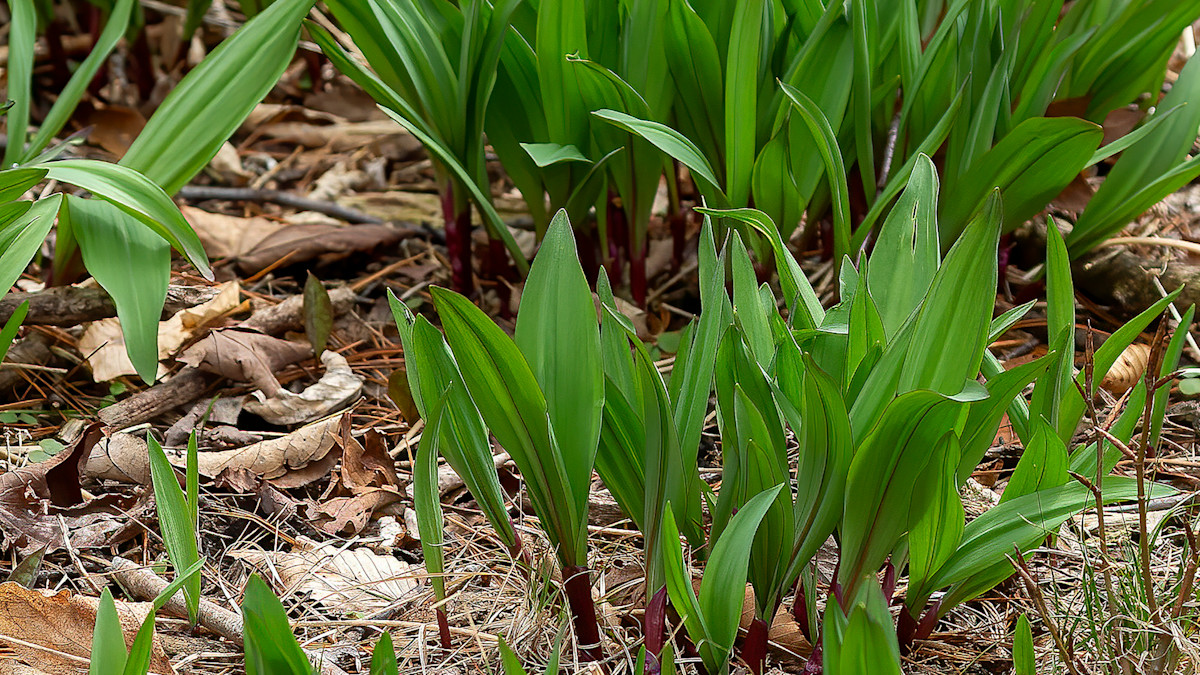
Ramps, also known as wild leeks, are one of the most coveted edible native plants in the North American forest. They are particularly prized by people in our area of Appalachia, where they have been collected and eaten for generations. They have a delicious mild garlicky flavor, and where you find one you often find about a million others. One of our annual traditions is trekking out to our favorite remote trout stream in the spring where we collect ramps that grow along the bank and catch a fish or two.
There is some concern that due to the growing commercial popularity of ramps, they might begin to become overharvested. In Canada, they are considered a rare species and are classified as a species of “special concern” in Maine and Rhode Island. We haven’t personally seen that to be the case where we live, but because of the looming threat, we do our best to propagate them in suitable areas on wild land and even in our own backyard. They are a bit different from typical garden vegetables, but they are surprisingly easy to cultivate.
Growing Conditions
Ramps (Allium tricoccum) are very long-lived perennial plants, so you should think of your ramp patch more like a fruit tree than an annual vegetable plant. They will not provide you with a significant harvest until they are a few years old, but from then on, they will feed you and whoever inherits them every spring for years to come.
The keys to a healthy ramp patch are rich soil and partial shade. If you have an area with deciduous trees whose leaves provide shade for most of the year, but let the sun through in the spring before they unfurl, this is an ideal spot for your ramp patch. Bonus points if the soil is regularly moist. In nature, ramps most often grow in floodplains and moist deciduous forests, but in our gardens we can help them by providing some water when conditions are especially dry.
There are two ways to initially start your ramp patch: from seed or from wild transplants. If you are growing ramps from seed you will likely need to purchase seeds online. To prepare the soil, rake out the planting area in the fall or early spring and scratch the soil surface to create some shallow indentations. Then you can sprinkle the seeds to spread them around the patch and brush your hand around to fill the shallow indentations on top of the seeds.
Remember that these are wild plants, so don’t expect the seeds to all sprout at exactly the same time. Often some will germinate one year and a few more the next. Growing ramps from seed is a long-term investment. If this isn’t quite your speed, you might consider starting your ramp patch from wild transplants.
If you know of a healthy wild ramp patch that can handle you removing a few, you can dig up the entire root in the early spring and simply dig a new hole for it in your garden. When digging the plants start your shovel or trowel at least 4 to 5 inches away from the base of the plant and dig it straight down before prying the plant out. This helps avoid damaging the thick white roots and bulbs. Water them regularly for the first month, and they should establish themselves just fine.
Depending on the age of the ramps that you transplant, they will produce flowers and round black seeds in their first year after transplanting. You can use these to further expand your ramp patch or share with a friend. We transplanted three ramp bulbs into our garden five years ago, and from the seeds they have produced and their vegetative reproduction (splitting of the bulbs), we now have healthy ramp patches all over the hill in our backyard!
Caring for Ramps
Because ramps are wild plants they require very little care and maintenance. If conditions are right, they require none. That said, some people might be growing them in a yard that receives more sun or less moisture than they prefer. If your ramps are in intense direct sunlight, the leaves might begin to wilt and flop over, which can be a bit concerning. Give them some water to help perk them up and consider planting a deciduous bush like a pawpaw or serviceberry above them to provide shade in the long term.
Ramps are an excellent addition to any native plant garden and a fun springtime tradition for families. Propagating them in your garden not only provides you flavor for spring meals but also contributes to the conservation of our prized native species.









Conversation